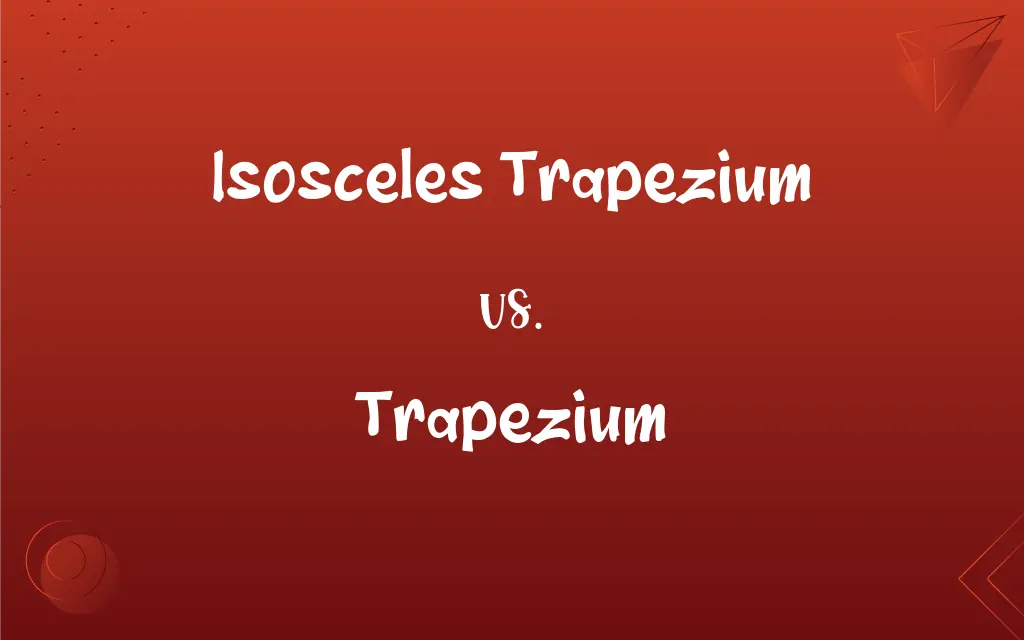Isosceles Trapezium vs. Trapezium: What's the Difference?
Edited by Aimie Carlson || By Janet White || Published on February 17, 2024
An isosceles trapezium has a pair of equal-length non-parallel sides, while a trapezium simply has one pair of parallel sides.

Key Differences
An isosceles trapezium is a special type of trapezium where the non-parallel sides are equal in length. This equality results in equal angles at the bases. On the other hand, a general trapezium is defined as a quadrilateral with only one pair of parallel sides. The lengths and angles of the non-parallel sides in a regular trapezium do not have to be equal, offering more varied shapes and angles compared to the isosceles trapezium.
The isosceles trapezium is known for its symmetry about a perpendicular bisector that cuts it into two equal halves. Each half is a mirror image of the other. In contrast, a trapezium lacks this symmetry unless it specifically conforms to the isosceles shape. The general trapezium can have irregular angles and side lengths, making it less symmetrical.
In an isosceles trapezium, the base angles are equal. This means that the angles adjacent to each base are of the same measure. In a standard trapezium, there is no such requirement for the base angles to be equal. The base angles in a trapezium can vary widely, giving it a more skewed appearance.
The isosceles trapezium can be inscribed in a circle, which is a unique property of this shape due to its symmetrical nature and equal angles. However, a regular trapezium does not generally have this property, as its unequal sides and angles prevent it from fitting perfectly within a circle.
Another notable difference is in the diagonals. In an isosceles trapezium, the diagonals are of equal length. In contrast, in a regular trapezium, there is no such condition, and the lengths of the diagonals vary.
ADVERTISEMENT
Comparison Chart
Side Lengths
Non-parallel sides are equal
Non-parallel sides vary
Symmetry
Symmetrical about a perpendicular bisector
Generally asymmetrical
Base Angles
Base angles are equal
Base angles are not equal
Inscribability in Circle
Can be inscribed in a circle
Cannot be inscribed in a circle
Diagonals
Diagonals are equal
Diagonals are not equal
ADVERTISEMENT
Isosceles Trapezium and Trapezium Definitions
Isosceles Trapezium
A symmetrical trapezium with non-parallel sides of the same length.
She drew an isosceles trapezium with its non-parallel sides measuring exactly 5 cm each.
Trapezium
A versatile geometric shape lacking uniform side lengths or angles.
The trapezium in the puzzle had irregular angles, making it challenging to solve.
Isosceles Trapezium
A trapezium that can be inscribed in a circle due to its symmetry.
The artist's isosceles trapezium perfectly fit inside a circular frame.
Trapezium
A non-symmetrical quadrilateral with varied diagonal lengths.
In our geometry project, we measured the different diagonals of a trapezium.
Isosceles Trapezium
A trapezium with equal base angles due to its isosceles properties.
In geometry class, we learned that the base angles of an isosceles trapezium are always equal.
Trapezium
A polygon that cannot generally be inscribed in a circle.
The architect explained why a trapezium cannot fit perfectly within a circular frame.
Isosceles Trapezium
A trapezium whose diagonals are of equal length.
The isosceles trapezium’s diagonals intersected at the midpoint, showing they were of equal length.
Trapezium
A four-sided figure with uneven sides and angles.
He noticed that the trapezium had one short and one long base.
Isosceles Trapezium
A quadrilateral with one pair of parallel sides and the other pair of equal length.
The isosceles trapezium in the park has two sides of equal length.
Trapezium
A quadrilateral with only one pair of parallel sides.
The trapezium-shaped garden bed enhanced the backyard’s aesthetic.
Trapezium
A quadrilateral having no parallel sides.
FAQs
Is an isosceles trapezium symmetrical?
Yes, an isosceles trapezium is symmetrical along a perpendicular bisector.
What is an isosceles trapezium?
An isosceles trapezium is a quadrilateral with one pair of parallel sides and the other pair being equal in length.
How are the base angles of an isosceles trapezium unique?
The base angles of an isosceles trapezium are equal.
Can a trapezium have equal base angles?
A general trapezium does not necessarily have equal base angles.
Is it possible for a trapezium to be inscribed in a circle?
Generally, a trapezium cannot be inscribed in a circle.
What defines a trapezium?
A trapezium is defined as a quadrilateral with only one pair of parallel sides.
How do you identify an isosceles trapezium?
Identify an isosceles trapezium by its equal non-parallel sides and base angles.
Can trapeziums vary greatly in shape?
Yes, trapeziums can vary widely in shape due to different side lengths and angles.
Can an isosceles trapezium be inscribed in a circle?
Yes, due to its symmetrical properties, an isosceles trapezium can be inscribed in a circle.
What role does a trapezium play in design and architecture?
In design and architecture, trapeziums add visual interest due to their unique and varied shapes.
Are the diagonals of an isosceles trapezium equal?
Yes, the diagonals of an isosceles trapezium are of equal length.
Can the sides of an isosceles trapezium be extended to meet?
Yes, the non-parallel sides of an isosceles trapezium can be extended to meet at a point.
What happens when you extend the sides of a trapezium?
Extending the sides of a trapezium may or may not result in them meeting, depending on the angles.
What about the symmetry of a general trapezium?
A general trapezium usually lacks symmetry.
Do trapeziums have equal diagonals?
In a general trapezium, the diagonals are not necessarily equal.
Is the isosceles trapezium a common shape in geometry?
The isosceles trapezium is a well-recognized and commonly studied shape in geometry.
Are isosceles trapeziums used in architecture?
Yes, isosceles trapeziums are often used in architecture for their symmetrical appeal.
How versatile is the shape of a trapezium in geometry?
The trapezium is quite versatile in geometry due to its varied possible dimensions and angles.
What distinguishes a trapezium from other quadrilaterals?
A trapezium is distinguished by having only one pair of parallel sides.
Are all isosceles trapeziums similar in shape?
All isosceles trapeziums share the characteristic of equal non-parallel sides and angles, making them similar in shape.
About Author
Written by
Janet WhiteJanet White has been an esteemed writer and blogger for Difference Wiki. Holding a Master's degree in Science and Medical Journalism from the prestigious Boston University, she has consistently demonstrated her expertise and passion for her field. When she's not immersed in her work, Janet relishes her time exercising, delving into a good book, and cherishing moments with friends and family.
Edited by
Aimie CarlsonAimie Carlson, holding a master's degree in English literature, is a fervent English language enthusiast. She lends her writing talents to Difference Wiki, a prominent website that specializes in comparisons, offering readers insightful analyses that both captivate and inform.
































































